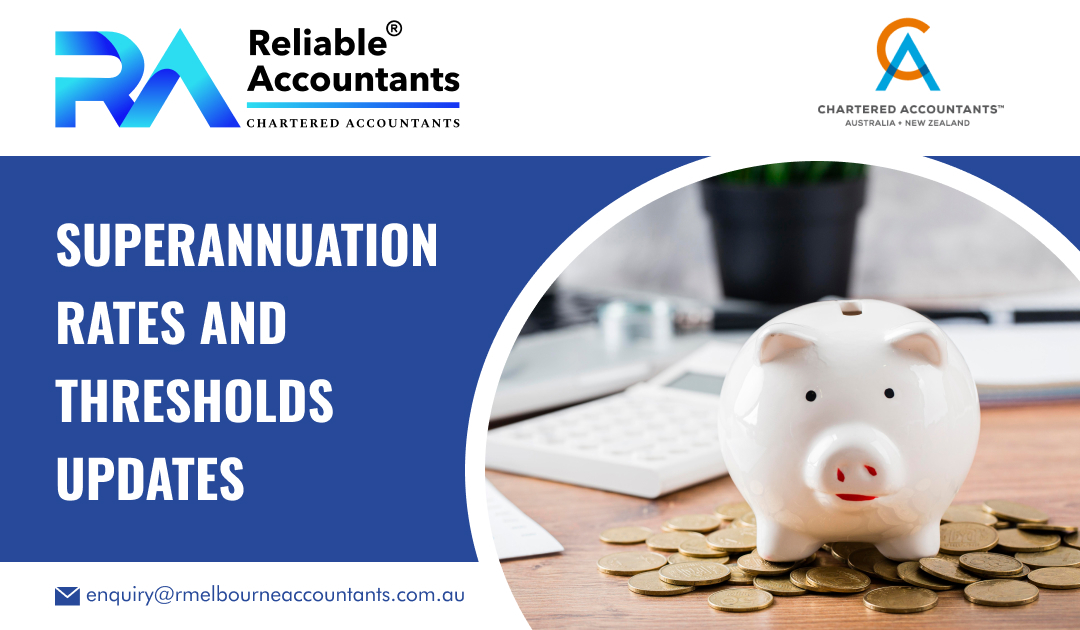Super Guarantee Rate Now 12%: What It Means For Employers
Starting from July 1, 2025, the SG rate has risen to 12% of ordinary time earnings (OTE). This marks the final step in the phased increase mandated by earlier reforms.
What’s Changed?
- Previous rate: 5% (until June 30, 2025)
- New rate: 12% (from July 1, 2025)
This change affects cash flow, payroll calculations, and employment agreements, especially where total remuneration includes superannuation.
Employer Checklist
Update payroll software to calculate 12% SG from July 1, 2025, pay runs.
Review employment contracts, as employees’ take-home pay might decrease unless renegotiated or the employer covers the extra SG cost.
Budget for higher super contributions and potential cash flow effects. Be aware that penalties for late or incorrect SG payments can include loss of deductions, interest, and other charges.
Personal Super Contributions
For 2025/2026, the concessional cap remains at $30,000 annually. The non-concessional cap is set at four times the concessional cap, totalling $120,000. Although the NCC cap hasn’t changed, individuals with less than $ 2 million in super balance can now make NCCs as of June 30, 2025, since the transfer balance cap has increased to $ 2 million. See the table below for TSB amounts for NCCs in 2025/2026.
| Total Super Balance – 30 June 2025 | NCC Cap | Allowable bring forward period |
| Less than $1.76m | $360,000 | 3 Years |
| $1.76m to $1.88m | $240,000 | 2 Years |
| $1.88m to $2.0m | $120,000 | No bring forward |
| $2.0m and above | Nil | Nil |
Personal Deductible Contributions
A superannuation fund member may be able to claim a deduction for personal contributions made to their super fund with personal after-tax funds. A member will qualify to claim a deduction if:
- The after-tax contribution is made by the member to their superannuation fund in the relevant financial year.
- They are aged under 67 or 67 to 74 and meet work test exemptions or the work test.
- They have given the superannuation fund a valid notice of intent to claim.
- The super fund has given the member an acknowledgement of the notice of intent to claim.
Notice of Intent to Claim
If the member qualifies and wants to claim a deduction, they must inform their super fund that they intend to claim a deduction. The notice should be valid and in the approved form – notice of intent to claim or vary a deduction for personal super contributions. The notice of intent to claim will be valid if:
- The individual is still a member of the fund.
- The fund still holds the contribution.
- It doesn’t include all or portion of an amount covered by a previous notice.
- The fund has not started paying a super income stream using any of the contributions.
- The contributions in the notice of intent have not yet been released from the fund to which the individual has provided notice under the FHSS scheme.
- The contributions in the notice of intent don’t include FHSSS amounts that have been recontributed to the fund.
What you need to consider
The member needs to provide the notice of intent to claim to the fund by the earlier of:
- The day the individual files their income tax return for the relevant financial year, or
- 30 June of the following year in which the contribution was made by the individual.
However, suppose a super fund member gives a notice of intent after rolling over their entire super interest to another fund, withdraws the entire super interest or starts a pension with any part of the contribution. In that case, the notice will not be valid. In simple words, the individual won’t be able to claim a deduction for the personal contributions made before the rollover or withdrawal.
Updated Superannuation and Tax Thresholds: 2025/2026
| 2024/2025 | 2025/2026 | |
| General transfer balance cap | $1,900,000 | $2,000,000 |
| Defined benefit income cap | $118,750 | $125,000 |
| CGT lifetime Cap | $1,780,000 | $1,865,000 |
| Untaxed plan cap – Lifetime | $1,780,000 | $1,865,000 |
| Superannuation Guarantee – Maximum Contributions base | $65,070 | $62,500 |
| PCG 2016/5 Safe Harbour rates for related party LRBA’s | 9.35% | 8.95% |
Remaining unchanged
The following thresholds will remain unchanged for the 2025/2026 financial year.
| Concessional contribution cap | $30,000 |
| Non-concessional contribution cap – standard | $120,000 |
| Non concessional contribution cap – maximum bring forward over 3 financial years | $360,000 |
| Division 293 – Annual adjusted taxable income | $250,000 |

